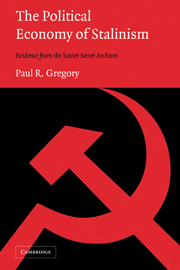Book contents
- Frontmatter
- Contents
- Illustrations
- Tables
- Preface
- 1 The Jockey or the Horse?
- 2 Collectivization, Accumulation, and Power
- 3 The Principles of Governance
- 4 Investment, Wages, and Fairness
- 5 Visions and Control Figures
- 6 Planners Versus Producers
- 7 Creating Soviet Industry
- 8 Operational Planning
- 9 Ruble Control: Money, Prices, and Budgets
- 10 The Destruction of the Soviet Administrative-Command Economy
- 11 Conclusions
- Appendix A Archival Sources
- Appendix B The Structure of the State
- Bibliography
- Index
2 - Collectivization, Accumulation, and Power
Published online by Cambridge University Press: 03 December 2009
- Frontmatter
- Contents
- Illustrations
- Tables
- Preface
- 1 The Jockey or the Horse?
- 2 Collectivization, Accumulation, and Power
- 3 The Principles of Governance
- 4 Investment, Wages, and Fairness
- 5 Visions and Control Figures
- 6 Planners Versus Producers
- 7 Creating Soviet Industry
- 8 Operational Planning
- 9 Ruble Control: Money, Prices, and Budgets
- 10 The Destruction of the Soviet Administrative-Command Economy
- 11 Conclusions
- Appendix A Archival Sources
- Appendix B The Structure of the State
- Bibliography
- Index
Summary
My grandfather grew up in a village where he cultivated the land with his brother and their children. His neighbor, Petya, was a ne'er-do-well, who slept on the porch of his ramshackle hut and spent his evenings drinking and beating his miserable wife. He would watch in disdain as we sweated in the hot sun building a new barn or brought home a new cow. During hard times, Petya would appear at our door asking for a handout. In 1929, Petya appeared at my grandfather's door accompanied by a handful of thugs, sporting a military uniform and cap bearing a red star, and declared: “In the name of Soviet power, I order you to hand over all your property and land to the collective.” This is why my grandfather hated communism and Soviet power all his life.
(Story told to the author in Moscow by a seventy-five-year-old Russian.)This book describes how and why a small group of socialist revolutionaries, led by one of history's worst tyrants, Josef Stalin, created the world's first administrative-command economy. The story is told from the records of the formerly secret Soviet archives from the same documents these “founders” used more than a half century earlier. This chapter describes the background of the 1929 decision to abandon the New Economic Policy (NEP) for a never-before-tried feat of social engineering: An entirely new system of economic and political management was to be created in short order, founded on the principles of the “leading role of the party” (read: dictatorship of the Communist Party), complete state ownership, and elimination of private economic activity.
- Type
- Chapter
- Information
- The Political Economy of StalinismEvidence from the Soviet Secret Archives, pp. 22 - 48Publisher: Cambridge University PressPrint publication year: 2003



